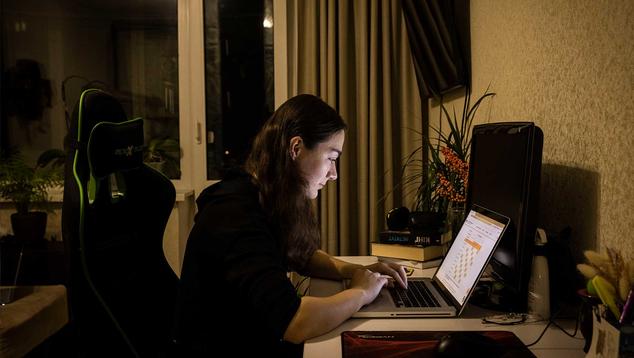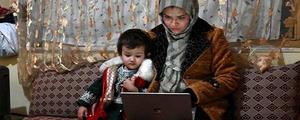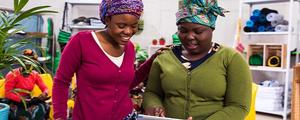A Conversation With Galina Zapryanova
Gallup's Regional Director for the World Poll in the former Soviet states and Eastern Europe
So, the U.N. Women’s theme for International Women’s Day this year focuses on the digital gender divide and how it feeds into widening economic and social inequalities around the world. Access to technology, of course, is a basic element of this.
You’ve been asking women (and men) in your region for years if they have access to the internet through their phone, computer or some other device.
In many of the countries in your region, there is a lot of parity between men and women -- when it comes to internet access. And access is pretty high. There are a few rare exceptions, including Tajikistan, which has one of the largest digital gender divides in the world: 50% of men and 30% of women have access.
Zapryanova: Yes, access to the internet has been growing in the vast majority of countries in Eastern Europe and post-Soviet Eurasia over the past decade. The pandemic accelerated this trend, and as you noted, by now, access to the internet is almost universal in many countries. For example, more older people who otherwise may not have had the need or interest to use the internet gained access so they could talk to their relatives and friends during lockdowns as well as take advantage of online services.
With access so high, many governments in Eastern Europe opted for a much larger online data collection aspect for their most recent population censuses in 2021-2022. The prior census round in 2011 had primarily relied on traditional face-to-face methodology, so in just a decade, we are seeing tremendous changes in how technology is transforming societies and institutions in the regions.
When internet access is so high overall, gender gaps also tend to disappear, which is what we are seeing across most of the region. Almost all women have mobile phones, and smartphones tend to be ubiquitous regardless of socioeconomic status. People would rather have a smartphone and subscribe for fewer minutes/data per month than get a basic “flip phone” with unlimited calling.
Of course, there are always some exceptions. In Tajikistan, we see a large gender gap in internet access. More than 70% of the country is rural -- the highest rural percentage in all Central Asia. We know that in rural areas, internet penetration is less widespread and traditional values are more common, so fewer women would have the resources or opportunity to connect.
There is an almost identical gender divide in mobile phone ownership in the country. In 2022, we found a 20-percentage-point gap between men and women who have access to a mobile phone for personal calls. There are, however, ongoing domestic and international efforts to narrow the gender gap in access to technology and improve internet access, in general, across the country.
More generally, what are some of the changes you’ve noticed over the years as women and men in your region have become more connected -- or not? What have you seen happening?
Zapryanova: Many workplaces and educational institutions have benefited from the digital revolution and generated cost and time savings for workers and companies. And, for individuals, widespread internet access certainly helped a lot during the pandemic. It helped people stay connected with their families and friends and follow key developments in the COVID-19 rules and guidelines issued by authorities. Shopping and online learning were also much easier than they would have been 10 years ago.
But these changes have not all been positive. Like in the rest of the world, there is concern that not all use of technology is good for people, especially children and youth. There is a relative consensus that online instruction during the pandemic, while better than nothing, caused widespread learning loss for children and put tremendous pressure on working parents.
Additionally, with the explosion of the internet and the proliferation of “casual” or inexperienced users, we have seen a lot of disinformation and articles of dubious journalistic quality circulate around social media. Of course, these challenges are by no means unique to our region, but they are more pronounced compared with Western countries. Nine out of 10 countries at the bottom of the Media Literacy Index in 2022 were in Eastern Europe.
Digitalization is rapidly transforming society; how has it transformed your region? What about women’s lives? I’m thinking specifically about women in Ukraine who almost universally have access to the internet. What has it meant for them?Zapryanova: Internet access has been really important for women in Ukraine during the war. From the start of the military action, Ukrainians started setting up online groups, channels and resources for those in need. It has been a lifeline for urgent things like getting ahold of transport and arranging logistics to leave town at short notice or arranging for your relatives in the East to leave, etc.
Being able to find information about humanitarian programs or simply staying connected with family members, relatives and friends on the front lines or those who left the country has been critical. In addition to government and international organizations’ official programs, internet access has allowed Ukrainians unprecedented ability to set up their citizen networks locally, nationally and globally to help each other in times of need.
Everyone contributes in some way -- whether by volunteering, donating money or simply resharing critical information. Gallup saw a historic high in the Civic Engagement Index in Ukraine in 2022. Both men and women are a part of this trend -- but with more men being actively employed in the military, many of the volunteering efforts are spearheaded by women.
OK. Let’s pivot to another topic that we talked a lot about last International Women’s Day: gender-based violence. This was a big problem in many countries in your region before the pandemic, and in many ways, it only became worse during the pandemic.
Zapryanova: Gender-based violence continues to be a problem in many countries. The easing of pandemic lockdowns, of course, brought some reprieve for the most at-risk populations, and we saw this reflected in our data collection in 2022. There was a drop in public perceptions in many Eastern European countries that domestic violence is a widespread problem in their country.
However, while perceptions of the magnitude of the issue have dropped, that is also to some extent due to bigger newsworthy stories occupying people’s attention -- the war in Ukraine, the refugee crisis, high inflation and economic concerns. So, the problems with domestic violence have not suddenly disappeared, but awareness and attention of the public to this issue have declined.
It is probably even more important in times like this for national and global organizations to continue their efforts to combat gender-based violence and make women’s voices heard. Amnesty International found in 2022 that, despite progress being made in terms of a legal framework for combating violence against women, there are still large institutional and practical barriers to preventing and addressing the problem.
Tell me about some of the positive changes you are seeing for women -- if you are seeing any. What gives you hope?
Zapryanova: Ukrainian women are showing remarkable resilience in the face of crisis, and their capacity to help each other in the most difficult moments should be a source of inspiration and hope for all of us.
Advances in educational achievements, STEM fields and women’s prospects in the workplace are also areas where women in East Europe and Central Asia are making tremendous progress. There is a lot of variation within such a broad region, of course, but the general trend is certainly a source of hope and pride for women in the region.
Read more stories about women around the world on our International Women's Day page.




